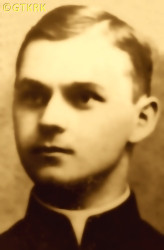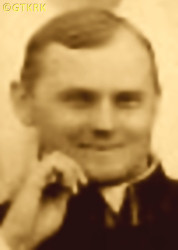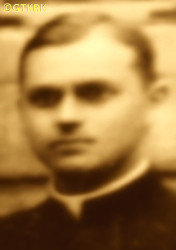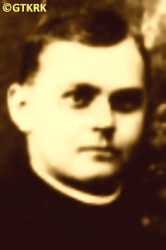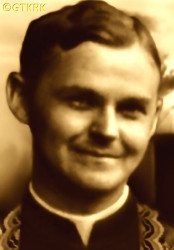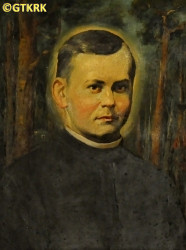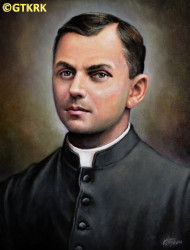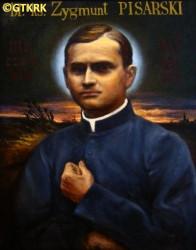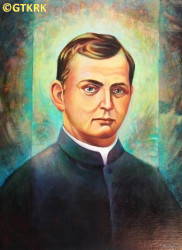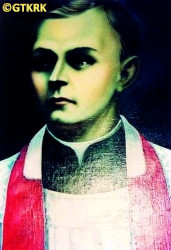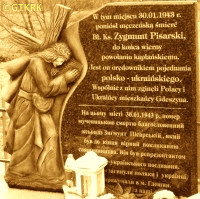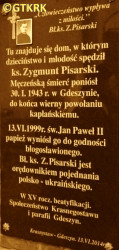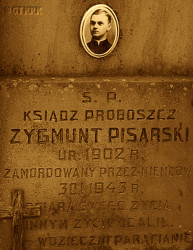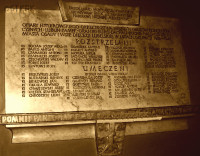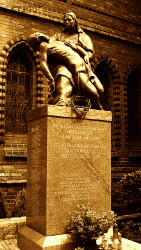Roman Catholic
St Sigismund parish
05-507 Słomczyn
85 Wiślana Str.
Konstancin deanery
Warsaw archdiocese, Poland
full list:
displayClick to display full list

searchClick to search full list by categories
wyświetlKliknij by wyświetlić pełną listę po polsku

szukajKliknij by przeszukać listę wg kategorii po polsku

Martyrology of the clergy — Poland
XX century (1914 – 1989)
personal data
religious status
blessed
surname
PISARSKI
forename(s)
Sigismund (pl. Zygmunt)
beatification date
13.06.1999more on
www.swzygmunt.knc.pl
[access: 2013.05.19]

the RC Pope John Paul IImore on
en.wikipedia.org
[access: 2014.09.21]
function
diocesan priest
creed
Latin (Roman Catholic) Church RCmore on
en.wikipedia.org
[access: 2014.09.21]
diocese / province
Lublin diocesemore on
pl.wikipedia.org
[access: 2013.05.19]
date and place
of death
30.01.1943

Gdeszyntoday: Miączyn gm., Zamość pov., Lublin voiv., Poland
more on
en.wikipedia.org
[access: 2021.09.29]
details of death
After German and Russian invasion of Poland in 09.1939 and start of World War II, his parish came under German occupation.
Attacked by Ukrainian nationalists — windows were broken in the rectory, was threatened with death. Finally, evicted from the church which, with the consent of the Germans, turned into an Orthodox church. Originally the church was built in 1899 as an Orthodox, but in 1915, during the World War I, most of the Orthodox — Russians — fled deep into Russia (the so‐called bezhenstvo), and after the rebirth of the Polish state in 1918, was handed over to Roman Catholics, although the Greek Catholics also laid a claim.
So he organized a chapel in his rectory.
After German attack on 22.06.1941 of their erstwhile ally, Russians, in the Zamość region the Germans began the implementation of the genocidal plan known as «Aktion Zamość», part of the General Plan for the East — the deportation of Poles, a total of c. 110,000 people, and the settlement of German settlers. Was then urged to leave the parish. Refused.
After the attack on 25.01.1943, by the Polish resistance partisans of the Home Army AK from the Hrubieszów district (part of the Polish Clandestine State) on the German settlers in the nearby Cieszyn village — as part of the so‐called Zamość Uprising, i.e. resistance against deportations — murdered during the retaliatory German pacification carried out in Gdeszyn, allegedly in search of partisans.
Claim was that the „communists” were ostentatiously sought, but this term was used by the Germans to describe all those who opposed them.
Refused to point out anyone, especially Ukrainian neighbors, including those who plundered his church.
Beaten and led towards the forest.
There placed facing a tree and shot in the back. As tried to get up, shot in the head.
Together with him, 6 other Poles and about 23 Ukrainians were murdered.
cause of death
mass murder
perpetrators
Germans
sites and events
«Aktion Zamość»Click to display the description, GeneralgouvernementClick to display the description, Ribbentrop‐MolotovClick to display the description, Pius XI's encyclicalsClick to display the description
date and place
of birth
24.04.1902

Krasnystawtoday: Krasnystaw urban gm., Krasnystaw pov., Lublin voiv., Poland
more on
en.wikipedia.org
[access: 2020.12.03]
parents
PISARSKI Stanislav
🞲 ?, ? — 🕆 ?, ?

BANASZKIEWICZ Vladislava
🞲 ?, ? — 🕆 ?, ?
baptism
26.04.1902

Krasnystawtoday: Krasnystaw urban gm., Krasnystaw pov., Lublin voiv., Poland
more on
en.wikipedia.org
[access: 2020.12.03]
St Francis Xavier RC church
presbyter (holy orders)
ordination
27.06.1926

Lublintoday: Lublin city pov., Lublin voiv., Poland
more on
en.wikipedia.org
[access: 2021.08.20]
St John the Baptist and St John the Evangelist RC cathedral churchmore on
en.wikipedia.org
[access: 2025.03.14]
positions held
01.09.1933 – 30.01.1943
parish priest — Gdeszyntoday: Miączyn gm., Zamość pov., Lublin voiv., Poland
more on
en.wikipedia.org
[access: 2021.09.29] ⋄ Assumption of the Blessed Virgin Mary RC parish ⋄ Hrubieszówtoday: Hrubieszów urban gm., Hrubieszów pov., Lublin voiv., Poland
more on
en.wikipedia.org
[access: 2021.08.20] RC deanery
11.01.1932 – 01.09.1933
administrator — Perespatoday: Tyszowce gm., Tomaszów Lubelski pov., Lublin voiv., Poland
more on
en.wikipedia.org
[access: 2021.08.20] ⋄ St Michael the Archangel RC parish ⋄ Tyszowcetoday: Tyszowce gm., Tomaszów Lubelski pov., Lublin voiv., Poland
more on
en.wikipedia.org
[access: 2020.09.24] RC deanery
01.04.1930 – 11.01.1932
administrator — Trzęsinytoday: Radecznica gm., Zamość pov., Lublin voiv., Poland
more on
en.wikipedia.org
[access: 2021.09.29] ⋄ St John the Baptist RC parish ⋄ Szczebrzeszyntoday: Szczebrzeszyn gm., Zamość pov., Lublin voiv., Poland
more on
en.wikipedia.org
[access: 2021.08.20] RC deanery
1928 – 01.04.1930
parish priest — Zamchtoday: Obsza gm., Biłgoraj pov., Lublin voiv., Poland
more on
en.wikipedia.org
[access: 2021.09.29] ⋄ St Josaphat the Bishop and Martyr RC parish ⋄ Tarnogródtoday: Tarnogród gm., Biłgoraj pov., Lublin voiv., Poland
more on
en.wikipedia.org
[access: 2020.11.27] RC deanery — new parish
1928
curatus/rector/expositus — Zamchtoday: Obsza gm., Biłgoraj pov., Lublin voiv., Poland
more on
en.wikipedia.org
[access: 2021.09.29] ⋄ St Josaphat the Bishop and Martyr RC church ⋄ Obszatoday: Obsza gm., Biłgoraj pov., Lublin voiv., Poland
more on
en.wikipedia.org
[access: 2020.09.24], Assumption of the Blessed Virgin Mary RC parish ⋄ Tarnogródtoday: Tarnogród gm., Biłgoraj pov., Lublin voiv., Poland
more on
en.wikipedia.org
[access: 2020.11.27] RC deanery — tasked to found a new parish
25.02.1928
vicar — Tarnogródtoday: Tarnogród gm., Biłgoraj pov., Lublin voiv., Poland
more on
en.wikipedia.org
[access: 2020.11.27] ⋄ Transfiguration of the Lord RC parish ⋄ Tarnogródtoday: Tarnogród gm., Biłgoraj pov., Lublin voiv., Poland
more on
en.wikipedia.org
[access: 2020.11.27] RC deanery — appointment, but withdrawn
27.06.1927 – 1928
vicar — Sóltoday: Biłgoraj gm., Biłgoraj pov., Lublin voiv., Poland
more on
en.wikipedia.org
[access: 2021.09.29] ⋄ St Michael the Archangel RC parish ⋄ Biłgorajtoday: Biłgoraj urban gm., Biłgoraj pov., Lublin voiv., Poland
more on
en.wikipedia.org
[access: 2020.12.03] RC deanery
11.01.1927 – 27.06.1927
administrator — Modliborzycetoday: Modliborzyce gm., Janów Lubelski pov., Lublin voiv., Poland
more on
en.wikipedia.org
[access: 2021.08.20] ⋄ St Stanislav the Bishop and Martyr RC parish ⋄ Janów Lubelskiform.: Janów Ordynacki
today: Janów Lubelski gm., Janów Lubelski pov., Lublin voiv., Poland
more on
en.wikipedia.org
[access: 2021.08.20] RC deanery
07.09.1926 – 11.01.1927
vicar — Modliborzycetoday: Modliborzyce gm., Janów Lubelski pov., Lublin voiv., Poland
more on
en.wikipedia.org
[access: 2021.08.20] ⋄ St Stanislav the Bishop and Martyr RC parish ⋄ Janów Lubelskiform.: Janów Ordynacki
today: Janów Lubelski gm., Janów Lubelski pov., Lublin voiv., Poland
more on
en.wikipedia.org
[access: 2021.08.20] RC deanery
1921 – 1926
student — Lublintoday: Lublin city pov., Lublin voiv., Poland
more on
en.wikipedia.org
[access: 2021.08.20] ⋄ philosophy and theology, Theological Seminary
sites and events
descriptions
«Aktion Zamość»: On 11.1942, the Germans began «Aktion Zamość» — a series of forced resettlement, an ethnic cleansing actions of the Polish population and pacification of Polish villages carried out in the Zamość region, in the territory of the Germ. Generalgouvernement (Eng. General Governorate) occupied by Germans, under the Germ. Generalplan Ost GPO (Eng. General Plan East), i.e. the plan of German settlement and Germanization of territories in Central and Eastern Europe. Until 08.1943, it covered a total of 100,000‐110,000 displaced Poles, including 30,000 children (some of them were taken from their parents and semt for a forced Germanization in German families) — most of them passed through the special Germ. UWZ Lager Zamość (Eng. resettlement camp in Zamość), where selection took place, e.g. group IV, children separated from parents. In place of the displaced, it was intended to settle 60,000 German colonists from Bessarabia, Ukraine, Bosnia, Serbia, Slovenia and Russia. In the first phase (28.11.1942‐03.1943) 116 villages were forcibly displaced — the displacements were carried out by Germ. Schutzpolizei units or the gendarmerie, with the help of the Ukrainian Auxiliary Police collaborating with Germany; in the second, as part of the so‐called Aktion Werwolf (06.1943‐08.1943) — 171 villages — the displacements were supervised by Wehrmacht and Waffen‐SS units, supported by the employees of UWZ Lager Zamość. As a result of the actions of the Polish resistance movement — during the so‐called Zamość Uprising, Polish partisans fought several large battles with the overwhelming German forces — 293 villages were displaced out of the 696 planned. In some villages Germans settled resettled Ukrainians — during the so‐called Ukraineraktion — under control of collaborating with Germans Ukrainian Support Committees among others. (more on: en.wikipedia.orgClick to attempt to display webpage
[access: 2021.08.20], journals.umcs.plClick to attempt to display webpage
[access: 2021.08.20])
Generalgouvernement: After the Polish defeat in the 09.1939 campaign, which was the result of the Ribbentrop‐Molotov Pact and constituted the first stage of World War II, and the beginning of German occupation in part of Poland (in the other, eastern part of Poland, the Russian occupation began), the Germans divided the occupied Polish territory into five main regions. In two of them new German provinces were created, two other were incorporated into other provinces. However, the fifth part was treated separately, and in a political sense it was supposed to recreate the German idea from 1915 (during World War I, after the defeat of the Russians in the Battle of Gorlice in 05.1915) of creating a Polish enclave within Germany. Illegal in the sense of international law, i.e. Hague Convention, and public law, managed by the Germans according to separate laws — especially established for the Polish Germ. Untermenschen (Eng. subhumans) — till the Russian offensive in 1945 it constituted part of the Germ. Großdeutschland (Eng. Greater Germany). Till 31.07.1940 formally called Germ. Generalgouvernement für die besetzten polnischen Gebiete (Eng. General Government for the occupied Polish lands) — later simply Germ. Generalgouvernement (Eng. General Governorate), as in the years 1915‐1918. From 07.1941, i.e. after the German attack on 22.06.1941 against the erstwhile ally, the Russians, it also included the Galicia district, i.e. the Polish pre‐war south‐eastern voivodeships. A special criminal law was enacted and applied to Poles and Jews, allowing for the arbitrary administration of the death penalty regardless of the age of the „perpetrator”, and sanctioning the use of collective responsibility. After the end of the military conflict of the World War UU, the government of the Germ. Generalgouvernement was recognized as a criminal organization, and its leader, governor Hans Frank, guilty of war crimes and crimes against humanity and executed. (more on: en.wikipedia.orgClick to attempt to display webpage
[access: 2024.12.13])
Ribbentrop‐Molotov: Genocidal Russian‐German alliance pact between Russian leader Joseph Stalin and German leader Adolf Hitler signed on 23.08.1939 in Moscow by respective foreign ministers, Mr. Vyacheslav Molotov for Russia and Joachim von Ribbentrop for Germany. The pact sanctioned and was the direct cause of joint Russian and German invasion of Poland and the outbreak of the World War II in 09.1939. In a political sense, the pact was an attempt to restore the status quo ante before 1914, with one exception, namely the „commercial” exchange of the so‐called „Kingdom of Poland”, which in 1914 was part of the Russian Empire, fore Eastern Galicia (today's western Ukraine), in 1914 belonging to the Austro‐Hungarian Empire. Galicia, including Lviv, was to be taken over by the Russians, the „Kingdom of Poland” — under the name of the General Governorate — Germany. The resultant „war was one of the greatest calamities and dramas of humanity in history, for two atheistic and anti‐Christian ideologies — national and international socialism — rejected God and His fifth Decalogue commandment: Thou shall not kill!” (Abp Stanislav Gądecki, 01.09.2019). The decisions taken — backed up by the betrayal of the formal allies of Poland, France and Germany, which on 12.09.1939, at a joint conference in Abbeville, decided not to provide aid to attacked Poland and not to take military action against Germany (a clear breach of treaty obligations with Poland) — were on 28.09.1939 slightly altered and made more precise when a treaty on „German‐Russian boundaries and friendship” was agreed by the same murderous signatories. One of its findings was establishment of spheres of influence in Central and Eastern Europe and in consequence IV partition of Poland. In one of its secret annexes agreed, that: „the Signatories will not tolerate on its respective territories any Polish propaganda that affects the territory of the other Side. On their respective territories they will suppress all such propaganda and inform each other of the measures taken to accomplish it”. The agreements resulted in a series of meeting between two genocidal organization representing both sides — German Gestapo and Russian NKVD when coordination of efforts to exterminate Polish intelligentsia and Polish leading classes (in Germany called «Intelligenzaktion», in Russia took the form of Katyń massacres) where discussed. Resulted in deaths of hundreds of thousands of Polish intelligentsia, including thousands of priests presented here, and tens of millions of ordinary people,. The results of this Russian‐German pact lasted till 1989 and are still in evidence even today. (more on: en.wikipedia.orgClick to attempt to display webpage
[access: 2015.09.30])
Pius XI's encyclicals: Facing the creation of two totalitarian systems in Europe, which seemed to compete with each other, though there were more similarities than contradictions between them, Pope Pius XI issued in 03.1937 (within 5 days) two encyclicals. In the „Mit brennender Sorge” (Eng. „With Burning Concern”) published on 14.03.1938, condemned the national socialism prevailing in Germany. The Pope wrote: „Whoever, following the old Germanic‐pre‐Christian beliefs, puts various impersonal fate in the place of a personal God, denies the wisdom of God and Providence […], whoever exalts earthly values: race or nation, or state, or state system, representatives of state power or other fundamental values of human society, […] and makes them the highest standard of all values, including religious ones, and idolizes them, this one […] is far from true faith in God and from a worldview corresponding to such faith”. On 19.03.1937, published „Divini Redemptoris” (Eng. „Divine Redeemer”), in which criticized Russian communism, dialectical materialism and the class struggle theory. The Pope wrote: „Communism deprives man of freedom, and therefore the spiritual basis of all life norms. It deprives the human person of all his dignity and any moral support with which he could resist the onslaught of blind passions […] This is the new gospel that Bolshevik and godless communism preaches as a message of salvation and redemption of humanity”… Pius XI demanded that the established human law be subjected to the natural law of God , recommended the implementation of the ideal of a Christian state and society, and called on Catholics to resist. Two years later, National Socialist Germany and Communist Russia came together and started World War II. (more on: www.vatican.vaClick to attempt to display webpage
[access: 2023.05.28], www.vatican.vaClick to attempt to display webpage
[access: 2023.05.28])
sources
personal:
pl.wikipedia.orgClick to attempt to display webpage
[access: 2014.12.20], nawolyniu.plClick to attempt to display webpage
[access: 2013.01.06]
bibliographical:
„Mysterium iniquitatis. Clergy and religious of the Latin rite murdered by Ukrainian nationalists in 1939‐1945”, Fr Józef Marecki, Institute of National Remembrance IPN, Kraków 2020
original images:
kresy.plClick to attempt to display webpage
[access: 2019.10.13], www.sdskstaw.ayz.plClick to attempt to display webpage
[access: 2019.10.13], www.sdskstaw.ayz.plClick to attempt to display webpage
[access: 2019.10.13], www.sdskstaw.ayz.plClick to attempt to display webpage
[access: 2019.10.13], www.niedziela.plClick to attempt to display webpage
[access: 2019.10.13], www.radiozamosc.plClick to attempt to display webpage
[access: 2019.10.13], commons.wikimedia.orgClick to attempt to display webpage
[access: 2019.10.13], www.sdskstaw.ayz.plClick to attempt to display webpage
[access: 2019.10.13], www.salon24.plClick to attempt to display webpage
[access: 2019.10.13], www.sdskstaw.ayz.plClick to attempt to display webpage
[access: 2019.10.13], monitor-press.comClick to attempt to display webpage
[access: 2019.10.13], www.radiozamosc.plClick to attempt to display webpage
[access: 2019.10.13], www.kresy.plClick to attempt to display webpage
[access: 2014.01.16], www.miejscapamiecinarodowej.plClick to attempt to display webpage
[access: 2014.05.09], www.szczecin.plClick to attempt to display webpage
[access: 2014.09.21]
LETTER to CUSTODIAN/ADMINISTRATOR
If you have an Email client on your communicator/computer — such as Mozilla Thunderbird, Windows Mail or Microsoft Outlook, described at WikipediaPatrz:
en.wikipedia.org, among others — try the link below, please:
LETTER to CUSTODIAN/ADMINISTRATORClick and try to call your own Email client
If however you do not run such a client or the above link is not active please send an email to the Custodian/Administrator using your account — in your customary email/correspondence engine — at the following address:

giving the following as the subject:
MARTYROLOGY: PISARSKI Sigismund
To return to the biography press below:
 Click to return to biography
Click to return to biography








